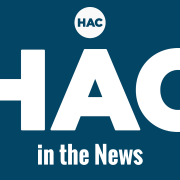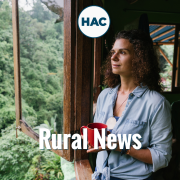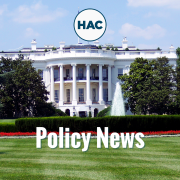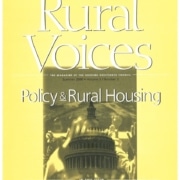HAC News Formats. pdf
June 25, 2015
Vol. 44, No. 13
• House subcommittee keeps most USDA spending at FY15 levels • Senate committee advances HUD bill with large cut in HOME • Supreme Court approves use of disparate impact for fair housing claims • Indian Country needs capital, witnesses tell Senate panel • Funds for housing and health research offered • Reminder: USDA has email lists for single-family housing loan programs • RD alters multifamily reserve account countersignature requirements • HUD Rental Assistance Demonstration changed • Federal homelessness plan revised • Homeownership down, renters’ cost burden rates increasing, Harvard reports • Partnership opportunities expand for housing and health providers
HAC News Formats. pdf
June 25, 2015
Vol. 44, No. 13
HOUSE SUBCOMMITTEE KEEPS MOST USDA SPENDING AT FY15 LEVELS. Approved by the House Agriculture Appropriations Subcommittee on June 18, the FY16 agriculture appropriations bill holds funding for Section 523 self-help at $27.5 million and increases Rental Assistance funds slightly to $1.167 billion, the amount the Administration said will be needed to keep up with inflation. It does not include minimum rent for tenants and does not provide vouchers for tenants in maturing mortgage properties. Details are on HAC’s website. The full House Appropriations Committee postponed a June 25 markup, and the Senate has not yet released an agriculture funding bill. [tdborder][/tdborder]
USDA Rural Dev. Prog.
(dollars in millions) |
FY13
Approp.a
|
FY14
Approp.
|
FY15
Approp.
|
FY16 Budget Proposal
|
FY16 House Subcmte. Bill
|
|
502 Single Fam. Direct
Self-Help setaside
|
$900
5
|
$900
5
|
$900
5
|
$900
0
|
$900
5
|
|
502 Single Family Guar.
|
24,000
|
24,000
|
24,000
|
24,000
|
24,000
|
|
504 VLI Repair Loans
|
28
|
26.3
|
26.3
|
26.3
|
26.3
|
|
504 VLI Repair Grants
|
29.5
|
28.7
|
28.7
|
26
|
28.7
|
|
515 Rental Hsg. Direct Lns.
|
31.3
|
28.4
|
28.4
|
42.3
|
28.4
|
|
514 Farm Labor Hsg. Lns.
|
20.8
|
23.9
|
23.6
|
23.9
|
23.9
|
|
516 Farm Labor Hsg. Grts.
|
7.1
|
8.3
|
8.3
|
8.3
|
8.3
|
|
521 Rental Assistance
|
907.1
|
1,110
|
1,089
|
1,172
|
1,167
|
|
523 Self-Help TA
|
30
|
25
|
27.5
|
10
|
27.5
|
|
533 Hsg. Prsrv. Grants
|
3.6
|
3.5
|
3.5
|
0
|
3.5
|
|
538 Rental Hsg. Guar.
|
150
|
150
|
150
|
200
|
150
|
|
Rental Prsrv. Demo. (MPR)
|
17.8
|
20
|
17
|
19
|
17
|
|
542 Rural Hsg. Vouchers
|
10
|
12.6
|
7
|
15
|
7
|
|
Rural Cmnty. Dev’t Init.
|
6.1
|
6
|
4
|
4
|
4
|
|
a. Figures shown do not include 5% sequester or 2.5% across the board cut.
|
SENATE COMMITTEE ADVANCES HUD BILL WITH LARGE CUT IN HOME. On June 25 the Senate Appropriations Committee approved a HUD funding bill for FY16 (not yet available online). The measure cuts the HOME program by 93%, from $900 million in FY15 to $66 million. An amendment to restore HOME funding was offered by Sen. Christopher Coons (D-DE) but was defeated. The bill does not make changes to the National Housing Trust Fund.
HUD Program
(dollars in millions) |
FY13
Approp.a
|
FY14
Approp.
|
FY15
Approp.
|
FY16
Budget
Proposal
|
FY16
House Bill
(H.R. 2577)
|
FY16 Sen. Approps. Cmte. Bill
|
|
Cmty. Devel. Fund
CDBG
|
3,308
2,948
|
3,100
3,030
|
3,066
3,000
|
2,880
2,800
|
3,060
3,000
|
2,900
2,900
|
|
HOME
SHOP setaside
|
1,000
b
|
1,000
b
|
900
b
|
1,060
10
|
767
b
|
66
b
|
|
Self-Help Homeownshp. (SHOP)
|
13.5
|
10
|
10
|
b
|
10
|
10
|
|
Tenant-Based Rental Assistance
VASH setaside
|
18,939.4
75
|
19,177.2
75
|
19,304
75
|
21,123
c
|
19,919
–
|
19,934
75
|
|
Project-Based Rental Asstnce.
|
9,339.7
|
9,516.6
|
9,330
|
10,360
|
10,254
|
10,426
|
|
Public Hsg. Capital Fund
|
1,886
|
1,875
|
1,875
|
1,970
|
1,681
|
1,743
|
|
Public Hsg. Operating Fund
|
4,262
|
4,400
|
4,440
|
4,600
|
4,440
|
4,500
|
|
Choice Neighbrhd. Initiative
|
120
|
90
|
80
|
250
|
20
|
65
|
|
Native Amer. Hsg. Block Grant
|
650
|
650
|
650
|
660
|
650
|
650
|
|
Homeless Assistance Grantsd
|
2,033
|
2,105
|
2,135
|
2,480
|
2,185
|
2,235
|
|
Hsg. Opps. for Persons w/ AIDS
|
334
|
330
|
330
|
332
|
332
|
330
|
|
202 Hsg. for Elderly
|
377
|
385.3
|
436
|
455
|
416.5
|
420
|
|
811 Hsg. for Disabled
|
165
|
126
|
135
|
177
|
152
|
137
|
|
Fair Housing
|
70.8
|
66
|
65.3
|
71
|
65.3
|
69.5
|
|
Healthy Homes & Lead Haz. Cntl.
|
120
|
110
|
110
|
120
|
75
|
110
|
|
Housing Counseling
|
45
|
45
|
47
|
60
|
47
|
47
|
|
Local Housing Policy Grants
|
–
|
–
|
–
|
300
|
–
|
–
|
|
a. Figures shown do not include 5% sequester. b. In FY13, FY14, and FY15 SHOP was funded under the Self-Help & Assisted Homeownership Opportunity Program account. Recent Obama budgets have proposed making the program a setaside in HOME. Congress has rejected that proposal. c. VASH vouchers for homeless veterans would be part of a new $177.5 million account of incremental rental vouchers for families, veterans, and tribal families experiencing homelessness and for victims of domestic violence. d. Includes the Rural Housing Stability Program, which is not yet operational.
|
SUPREME COURT APPROVES USE OF DISPARATE IMPACT FOR FAIR HOUSING CLAIMS. On June 25 the court ruled in Texas Department of Housing and Community Affairs v. Inclusive Communities Project, Inc. that a Fair Housing Act claim may be based on a disproportionately adverse impact on minorities even where there is no discriminatory intent.
INDIAN COUNTRY NEEDS CAPITAL, WITNESSES TELL SENATE PANEL. “Accessing Capital in Indian Country,” an oversight hearing by the Senate Indian Affairs Committee, focused on business financing, but touched on housing as well. Witnesses spoke favorably of HUD’s Section 184 program, CRA, and the Native American CDFI program. One recommended allocating Low Income Housing Tax Credits directly to tribes.
FUNDS FOR HOUSING AND HEALTH RESEARCH OFFERED. Nonprofits, for-profits, tribes, PHAs, state and local govern-ments, and others can submit preapplications by July 16 for Healthy Homes Technical Studies grants. Contact Dr. Peter Ashley, HUD, 202-402-7595.
REMINDER: USDA HAS EMAIL LISTS FOR SINGLE-FAMILY HOUSING LOAN PROGRAMS. Sign up for a list that distributes information about Section 502 direct, 504, and 523, or for others covering the Section 502 guarantee program, at https://www.rdlist.sc.egov.usda.gov/listserv/mainservlet.
RD ALTERS MULTIFAMILY RESERVE ACCOUNT COUNTERSIGNATURE REQUIREMENTS. A final rule provides that when a property has both a Section 515 or 514 loan and also a Section 538 loan, USDA’s countersignature will not be required to draw funds from the reserve account. (See HAC News, 8/20/14.) The rule also requires guarantee fees to be paid from operating accounts, not reserve accounts. Contact Tammy S. Daniels, RD, 202-720-0021.
HUD RENTAL ASSISTANCE DEMONSTRATION CHANGED. A notice in the June 26 Federal Register will expand and amend RAD, which allows some public housing to convert to long-term, project-based Section 8 rental assistance. Comments will be due in 30 days. Contact rad@hud.gov.
FEDERAL HOMELESSNESS PLAN REVISED. The U.S. Interagency Council on Homelessness updated its “Opening Doors” strategy and added an operational definition of ending homelessness: “An end to homelessness does not mean that no one will ever experience a housing crisis again. . . . [It] means that every community will have a systematic response in place that ensures homelessness is prevented whenever possible or is otherwise a rare, brief, and non-recurring experience.” USICH also says chronic homelessness can be ended in 2017 (rather than the original 2015 goal) if Congress funds new permanent supportive housing.
HOMEOWNERSHIP DOWN, RENTERS’ COST BURDEN RATES INCREASING, HARVARD REPORTS. In its annual State of the Nation’s Housing study, the Joint Center on Housing Studies says that in 2013, almost half of all renters had housing cost burdens, including more than a quarter who were paying more than 50% of income for housing). The report notes that cuts in federal funds and increases in subsidy costs add to the problem, and that expiring affordability requirements will be a serious issue over the next decade.
PARTNERSHIP OPPORTUNITIES EXPAND FOR HOUSING AND HEALTH PROVIDERS. Affordable Housing’s Place in Medicaid Reform: Opportunities Created by the Affordable Care Act and Medicaid Reform examines how changes in health care law create the potential for affordable housing providers to collaborate with health care providers and others. The report, published by the National Housing Conference, includes examples of programs already underway.





